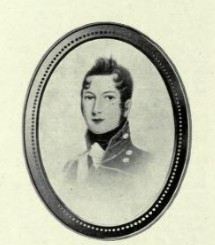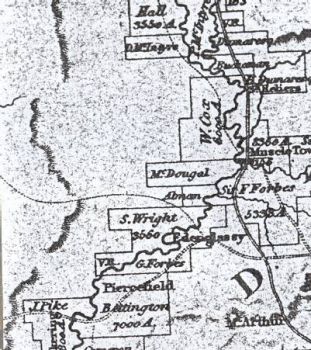William Barry
Mariner 1827; Segenhoe 1828; shepherd
In 1819 Mrs. William Cox died, leaving five sons, and two years later Mr. Cox married again, adding to his family three sons and a daughter. William Cox (the elder) died in 1837 at the age of 72 years, leaving behind him a reputation second to none among those grand old pioneers who laid the foundations of the Mother State. His numerous sons, too, left their names on the records of the early pastoral development of the State, and themselves left large families of worthy descendants to the present generation. It may be briefly stated that of William Cox's first family
1).William Cox, junr. - who served as a young officer in the Peninsula War - came out to New South Wales and married the daughter of Captain Piper, after whom Point Piper, Sydney, was named. He founded Hobartville, near Windsor, and afterwards took up station properties near Muswellbrook and near Warialda.
2).George inherited Clarendon (which Chas. H. Cox, J.P. was afterwards sold by his son, Charles Clarendon, to Mr. Arthur Dight), and himself founded Wimbourne. He married Elizabeth, the daughter of Lieut. Archibald Bell, of 'Bell's Line' fame.
3). James went to Tasmania and founded Clarendon, near Launceston.
4). Henry possessed much property in the Mudgee district.
5). Edward lived and died at Mulgoa.
Of the second family, Edgar inherited 'Hereford.' Thomas became a clergyman and went to England; he inherited some Sydney city property from his father. Alfred became the owner of 'Burrandong,' but sold it and settled in New Zealand. The daughter married Captain Isherwood and moved to England. [5]
 William Cox of Hobartville son of William Cox the elder of Clarendon, first arrived on the Experiment in 1804. He purchased a commission in the New South Wales Corps in 1808 before returning to England with that regiment, being promoted to Lieutenant in 1812. He returned to the Colony in 1814 on the Windham as a member of 46th Regiment; he purchased the estate of Hobartville near Richmond in 1816. [1]
William Cox of Hobartville son of William Cox the elder of Clarendon, first arrived on the Experiment in 1804. He purchased a commission in the New South Wales Corps in 1808 before returning to England with that regiment, being promoted to Lieutenant in 1812. He returned to the Colony in 1814 on the Windham as a member of 46th Regiment; he purchased the estate of Hobartville near Richmond in 1816. [1]William Cox the elder of Clarendon and his son William Cox of Hobartville, between them purchased 8000 acres to form the estate of Negoa. William Cox of Clarendon who made the Blue Mountains Road to Bathurst, was authorised on 3 May 1825, to purchase 4000 acres and William of Hobartville was permitted to purchase an equal area by an order dated 23 June 1825. When William the elder had completed the purchase of some of this land he sold it to William of Hobartville, who purchased the remainder of his father's reserve to complete the 8000 acres in Negoa. [2]
 On 9th March 1846 William Cox (of Hobartville) divided Portion 3 (2560 acres) and Portion 4(1280 acres) between his sons, William (third generation William), John Hobart and Sloper.
On 9th March 1846 William Cox (of Hobartville) divided Portion 3 (2560 acres) and Portion 4(1280 acres) between his sons, William (third generation William), John Hobart and Sloper.Descendants of William Cox the elder are now settled in Queensland and in the northern parts of New South Wales. Charles Hobart Cox, J.P., of 'The Oaks,' Muswellbrook, is the third son of John Cox, who was the second son of William Cox, junr., of Hobartville. The latter married his cousin, Georgina, the daughter of George Cox, of Wimbourne, who had married Miss Bell and had eight sons and four daughters. John Cox had Negoa, near Muswellbrook, which still belongs to his three daughters, and also the Well Station, near Muswellbrook, of which his son, Charles Hobart Cox, bought half at his father's death and named 'The Oaks,' there being many oaks growing in the creek which runs through the property. It is nine miles from Muswellbrook, and consists of 3,500 acres of basalt country, undulating, with creek flats, and is timbered with box and currajong, with a sprinkling of ironbark. It carries a good flock of Lincoln crossbred sheep, and a few cattle and horses......... - Australia Unlimited by Edwin James Brady [5]
The Oaks Estate. There is a charm, not in ' the pathless woods,' that Lord Byron's misanthropic spirit craved for, but in a homestead and estate where trees abound, where the art of the builder, the gardener, and the stockbreeder combine and blend natural and artificial beauty' into one harmonious whole. That is the impression one naturally feels jn glancing at the homestead, the crossbred lambs, the ewes and weaners, and the dairy herds in the paddocks, of the Oaks Estate, the property of Mr C H. Cox, on Coal Creek, about eight miles west of Muswellbrook, in the Hunter River district of New South Wales. The property is a charming one in every way - the homestead is embowered amidst ornamental and fruit bearing trees, and the tennis court, hedged and fenced as part of the garden, orchard and grounds, give a completeness to the view that is not often obtained. So, too, with the sheep and the Iambs, and the cattle in the paddocks. There are the stock in pastures up to their bellies; there is plenty of grass in the paddocks, and also trees for shelter, for breaking the winds and receiving the showers and torrential rains. The Oaks Estate comprises about 4000 acres of practically all cultivatable land ; about 300 acres are under crops, 200 of which grow lucerne - used principally for topping up the sheep and lambs for market. The estate was formerly part of the Negoa property. Negoa was taken up by Mr. William Cox, of Hobartville, who knew good land when he saw it. So, too, with Mr. C. H. Cox; for not only are nearly all the 4000 acres agricultural land, but the estate is well watered, and capable of great things. As it is there are 4000-sheep on the estate, 2000 of which are breeding ewes, which in these times are not only a valuable asset to the owner, but of considerable importance to the whole country. Good breeding ewes on good pastures mean that the country will not be so long in stocking up as it was at one time feared. Mr. Cox has a small dairy herd, in addition to his sheep, but breeding and fattening sheep are his forte.[6]